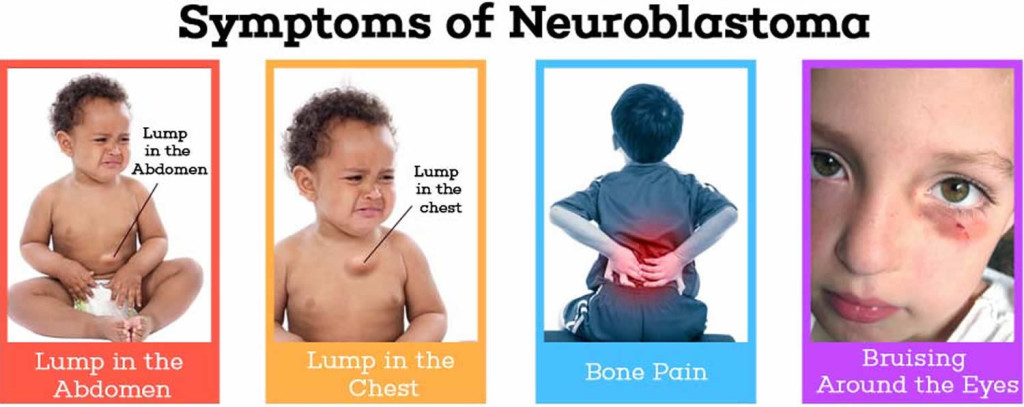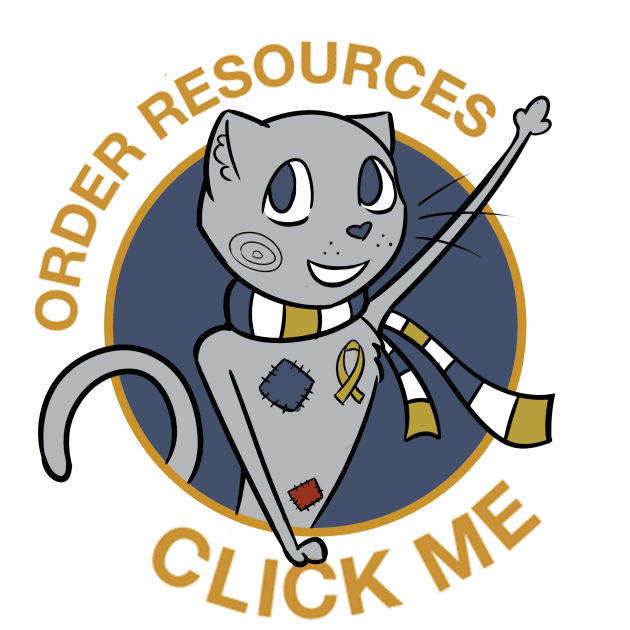Neuroblastoma
Neuroblastoma is the most common form of cancer in children under the age of one, and accounts for about 6% of all types of childhood cancers. It develops in neuroblasts, or immature nerve cells, that should eventually mature into nerve cells. In most cases, neuroblastoma is detected after a parent or guardian notices unusual symptoms, which often relate to the origin site of the neuroblastoma. About 33% of neuroblastomas begin in the nerve clusters near the adrenal glands. About 25% start in the sympathetic ganglia (a type of nerve cell cluster) in or near the abdomen. About 42% of neuroblastomas begin in sympathetic ganglia near the spine. However, in a majority of cases (about 66%), the cancerous cells have spread to the lymph nodes and/or bones at the time of diagnosis.
Common Symptoms of Neuroblastoma
Because neuroblastoma occurs most frequently in newborns and very young children, a neuroblastoma diagnosis is usually made after a parent, guardian, or caretaker notices one or more unusual symptoms and takes the child to a pediatrician. The most common symptoms of neuroblastoma include:
- Enlarged belly
- Swelling in the legs or in the face, neck, and/or upper chest
- Lump or swelling in the abdomen or neck, usually without pain
- Bluish lumps or bumps in the skin
- Weight loss
- Not eating or complaining about feeling full
- Issues with urinating or bowel movements
- Issues breathing or swallowing
- Bone pain
- Drooping eyelid and small-looking pupil in one eye
- Bulging eyes and/or bruising around the eyes
- Issues with being unable to feel or move parts of the body
 In many cases, symptoms of neuroblastoma are caused by a tumor, or mass of cancerous cells, that becomes visible through the skin or begins to press on other organs of the body. The location of the primary tumor will impact the specific symptoms the child is experiencing. For instance:
In many cases, symptoms of neuroblastoma are caused by a tumor, or mass of cancerous cells, that becomes visible through the skin or begins to press on other organs of the body. The location of the primary tumor will impact the specific symptoms the child is experiencing. For instance:
- Tumor in the abdomen or pelvis: If the tumor is located in the abdomen or pelvis, a loved one may notice a large lump or swelling in that area. Usually the swelling is not painful. However, it can cause the child to eat less; he or she may complain of feeling full or experience belly discomfort. These symptoms can, over time, lead to weight loss. If the tumor begins to press against blood or lymph vessels, it can lead to swelling in the legs and, for boys, the scrotum. It can also impact the bladder or intestines, causing issues with urination or bowel movements.
- Tumors in the chest or neck: Tumors located in the neck may look or feel like a hard, painless lump. When located in the chest, the tumor may begin to press on the superior vena cava, a large vein through which blood exits the head and neck. This pressure may lead to swelling in the face and upper body, sometimes accompanied by a bluish-red skin color. It may lead to headaches, dizziness, or even a change in consciousness. If the tumor begins to press on the throat or windpipe, it can cause coughing or trouble swallowing or even breathing. A tumor that presses on specific nerves in the neck or chest will lead to symptoms in the areas that nerve controls, such as the eyes or the limbs.
Symptoms caused by neuroblastoma that has spread
In about two-third of all neuroblastoma cases, the neuroblastoma has spread beyond its point of origin into other areas of the body, usually the lymph nodes and/or the bones. As the cancer spreads, it begins to cause symptoms in other ways. For instance, if it has spread to the lymph nodes, the cancerous cells may cause the lymph nodes to swell. While in the vast majority of cases, swollen lymph nodes are caused by a common infection, they should be checked by a physician.
Neuroblastoma can also spread to the bones, which can be extremely painful. It may cause the child to complain of bone pain (if old enough to talk), or cause the child to limp or refuse to walk. If it spreads to the bones in the spinal cord, it can lead to weakness, numbness, or even paralysis in the arms and/or legs. If it spreads to the bones around the eyes, it can lead to bruising or bulging eyes. If it spreads to the bones of the skull, it can cause bumps under the scalp.
One particular type of neuroblastoma, found only in the first few months of life, is known as Stage 4S neuroblastoma because the tumor has spread to the liver, the skin, and/or the bone marrow. This leads to very specific symptoms such as blue or purple bumps on the skin, an enlarged liver felt as a mass on the right side of the abdomen, and difficulty breathing if the tumor has grown large enough to press on the lungs. However, despite the fact that it is widespread, Stage 4S neuroblastoma is very treatable, and sometimes even shrinks or disappears on its own.
Paraneoplastic Syndromes
Paraneoplastic syndromes are problems stemming from hormones released by the neuroblastoma. These unusual hormones can impact the normal functioning of nearby tissues or organs, even if the tumor itself has not spread into those areas. This can lead to a range of additional symptoms, including:
- Fever
- High blood pressure (irritability)
- Rapid heartbeat
- Constant watery diarrhea
- Reddening or flushing of the skin
- Sweating
And most unusually, neuroblastoma can cause a set of symptoms called opsoclonus-myoclonus-ataxia syndrome or “dancing eyes, dancing feet.” A child with this syndrome will have irregular and rapid eye movements and twitch-like muscle spasms, and will lack coordination when standing or walking. Although researchers do not understand why, neuroblastomas in children who exhibit these unusual symptoms seem to be less life-threatening that other forms of neuroblastoma.
Request for free resources here.
 More about Childhood Neuroblastoma Cancers:
More about Childhood Neuroblastoma Cancers:
- About Childhood Neuroblastoma Cancer – Detection and Diagnosis
- Causes, Risk Factors, and Prevention of Childhood Neuroblastoma Cancer
- What are the signs and symptoms of Childhood Neuroblastoma Cancer?
- Childhood Neuroblastoma Cancer Treatment
- Childhood Neuroblastoma Cancer – Stages and Prognosis
- What is the expected life span of Childhood Neuroblastoma Cancer?
- After Treatment – Living as a Childhood Neuroblastoma Cancer Survivor
Learn More About the Different Types of Childhood Cancers:
- Childhood Brain Tumor Cancer (Brain Stem Tumors)
- Spinal Cord Tumor Cancer
- Childhood Neuroblastoma Cancers
- Childhood Hodgkin Lymphoma Cancers
- Non-Hodgkin Lymphoma Cancers
- Wilms tumor (Kidney Tumors)
- Rhabdomyosarcoma
- Retinoblastoma
- Bone cancer (including osteosarcoma and Ewing sarcoma)
- Leukemia Cancers: Acute lymphocytic (lymphoblastic) leukemia (ALL) Acute myelogenous leukemia (AML); Juvenile myelomonocytic leukemia (JMML)
- Hepatoblastoma (Liver Cancer)
- Rhabdoid Tumors


